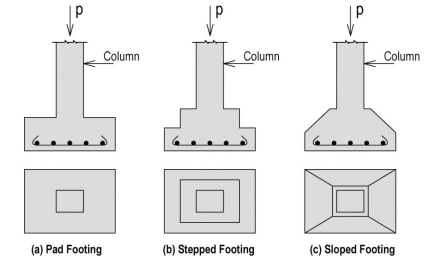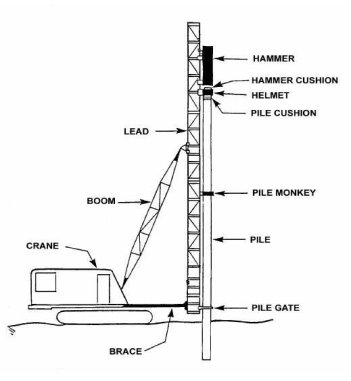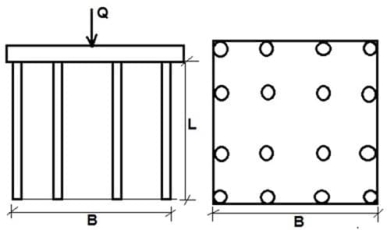Unit-3
Design of shallow foundation
To perform satisfactorily:
Design considerations
FOUNDATION TYPES
SHALLOW
DEEP

Fig no. 1 Types of shallow footing
SINGLE FOOTING
Types
A strip footing (continuous footing) supports a load wall or cluster of columns.
Combined Footing supports a variety of columns.
SHALLOW FOUNDATION DESIGN
BEARING CAPACITY
TERZAGHIS BEARING CAPACITY THEORY FOR SHALLOW FOUNDATION

For a strip footing:
q u l t = 1/2  BN
BN + c N c +
+ c N c +  Df N q
Df N q
Where
Qu: final bearing capability
N: Bearing capability issue because of the weight of soil with zero surcharge
N c: Bearing capability issue because of cohesion of soil, presumptuous soil to be weightless and surcharge as zero
N q: Bearing capability issue because of surcharge pressure, q o=  D associate horizontal plane at foundation base level, presumptuous soil below foundation as weightless
D associate horizontal plane at foundation base level, presumptuous soil below foundation as weightless
For a square footing with aspect B
q u l t = 0.4  BN
BN  + 1.3 c N c +
+ 1.3 c N c + Df N q
Df N q
For a circular footing with diameter D:
q u l t = 0.3  D N
D N + 1.3 c N c +
+ 1.3 c N c +  Df N q
Df N q
Note: For an oblong footing (L*B) use linear interpolation between strip footing (B/L=0) and sq. footing (B/L=1.0)
N c rect = N c strip [1 + 0.2 (B/L)]
N  rect = N
rect = N strip [1 - 0.2 (B/L)]
strip [1 - 0.2 (B/L)]
N q rect = N q strip
*For identical soil conditions, for various foundation shapes, q u l tvalues square measure differently.
Key takeaways
Shallow foundation
Deep foundation
Masonry, steel, plain concrete like
Settlement failure
Bearing capability failure
The main objectives of foundation style are to make sure that the structural masses are transmitted to the subsoil(s) safely, economically, and with none unacceptable movement throughout the development amount and the anticipated lifetime of the building or structure
Basic style Procedure
This can be thought-about as a series of steps or stages
Isolated footing

Fig no 2 Isolated footing
Strip footing

Fig no. 3 Strip footing
2 ways may be accustomed to analyzing the strip footings.
Rigid Analysis
Footing space = (Total Column Load) / (Allowable Bearing Pressure)
Flexible Analysis
Subgrade Reaction = (SF)x 40 x (Allowable Bearing Capacity)
Key takeaways
Isolated foundation
Strip footing – 2 ways may analyze the strip footing
Rigid analysis technique
Flexible analysis technique
Introduction

Fig no. 4 Deep foundation
Methods of pile forming
1. Pile driving
2 Pile driving hammers
3. Jetting of piles
4. Pile driving by vibration
Pile Driving

Fig no. 5 Pile driving
Pile Driving Hammers
![CG_6028] Single And Double Action Diagram Free Diagram](https://glossaread-contain.s3.ap-south-1.amazonaws.com/epub/1642793424_7268367.png)
Fig no. 6 Pile driving hammers
JETTING OF PILES

Fig no. 7 Jetting piles
Pile Driving by Vibration
Key takeaways
Method of pile forming
Following effects are ascertained
1. It causes compaction of loose sandy soils to a radial distance of two to three times pile diameter, D closes the pile and concerning a pair of times, the diameter below the tip takes place. Subsidence happens as a result of compaction. Soil compaction will increase pile capability.
2. Re mould of sensitive clays leads to a loss of strength within the close soil upto a radial distance of D (upto ninetieth of strength is regained by impact in around thirty ten fifty days) A zone of thickness D on the far side re mould zone gets consolidated.
3. Shocks throughout driving might cause a physical change of saturated fine sands and silts.
4. Surface heaving takes place in dense sandy soils thanks to the loosening impact of vibration and because of the plastic flow of soils.
5. Squirting will have a prejudicial scouring effect on non-cohesive soils below existing neighboring structures and might cause the fast sand condition.
6. Concretion of soils behind holding walls increases the lateral pressure.
7. Displacement piles behind holding walls might cause lateral soil movement and develop passive pressure.
8. Piles additionally get broken because of the following
(a) Overdriving or improper driving
(b) Deviation from alignment
(c) Use of defective piles
(d) Obstruction of boulders.
9. The piles should be protected at high and tip by soft pile cap and dolly at high and shoe at the tip.
<1, whereas for sands it is > one

Fig no. 8 Efficiency of piles drive
 = Q g/N Q p
= Q g/N Q p
Where Q g = group capability
N = No. of piles
Q p = single pile load
For friction piles, cluster potency n is often as high as a hundred% for the spacing of piles > 5D and low as fifty-five you take care of spacing <2.5 D. whereas spacing > 4.5 D is uneconomical.
There is no precise methodology for estimating the settlement of pile teams. Therefore, Associate in approximate methodology is mentioned
Pile groups in Cohesive Soil

Fig no. 9 Settlement of piles group for cohesive soil
(a) Immediate settlement
S I =  q n B/E (1-
q n B/E (1-  2) I p
2) I p
Where q n, = net pressure on the equivalent raft at depth2Df/3,
B = breadth of the equivalent raft at depth 2 D f/3
 = Poisson's quantitative relation of soil below the depth equivalent raft
= Poisson's quantitative relation of soil below the depth equivalent raft
E = coefficient of elasticity of the soils below the equivalent raft
= (500 - 1000) C u
I p = influence constant, f(L/B), and
 = depth correction factor f (Df /B, L/B)
= depth correction factor f (Df /B, L/B)
(b) Consolidation settlement
The consolidation settlement of the pile group is obtained from the quality equation,
S c = [ (C c/1 +e o) H log (P o +
(C c/1 +e o) H log (P o + P/Po)]
P/Po)] 
S c = (∑ m v p H)
p H) 
Where, C c/ (1 + e o) and m, square measure severally the compressibility index and therefore the constant of volume decrease for the suitable stress level of the relevant strata.
H is that the thickness of strata,
P o and  p square measure the unmoved vertical effective stress and therefore the increase of stress within the various strata, and
p square measure the unmoved vertical effective stress and therefore the increase of stress within the various strata, and
 AND
AND square measure severally the depth and pore-pressurecorrection factors.
square measure severally the depth and pore-pressurecorrection factors.
to know the effective depth of soil below the cluster, the simplest methodology is to see the strain increment quantitative relation  p/p, at completely different depths and think about the depth of soil that
p/p, at completely different depths and think about the depth of soil that  p/p> zero.1.
p/p> zero.1.
 H = s q u / [N 0.81 (1 +0.4 D f/B)]
H = s q u / [N 0.81 (1 +0.4 D f/B)]
Where  H = settlement
H = settlement
s= settlement constant,
q u = average pressure on the equivalent raft,
N = average SPT worth over a depth 2B below the muse level or D s if the depth of cohesionless soil is a smaller amount than 2B.
Df = depth of equivalent raft, and
B = breadth of equivalent raft.
The settlement constant, s vanes with Df/ B
Key takeaways
Settlement of piles –
Piles group in cohesive soil




Piles group in cohesionless soil.

Fig no. 10 Negative skin friction
Determination
The magnitude of F n is determined as
Fn =Q s (kin resistance) = A s f s
Where p = Pile perimeter π D
D p or Lp = Length of the pile at intervals compressible layer
Fs = S u =Un drained shear strength of compressible soil
2. For granular soil
F n = ½ L p2 p  k tan
k tan  <= tan
<= tan 
K = coefficient of lateral pressure
 = unit weight of soil
= unit weight of soil
3. For pile group
(Fn) g= N (F n) 1
(Fn) g= c L p p +  L p A
L p A
(Fn) g= c L p +p  L p A = L p [c p +
L p A = L p [c p +  A]
A]
Where A = area enclosed in perimeter p of a group of piles
Measure to minimize F n
Prevention:
Key takeaways



(F n) g= N (F n) 1
(F n) g= c L p p +  L p A
L p A
(F n) g= c L p +p  L p A = L p [c p +
L p A = L p [c p +  A]
A]
Double piles
End bearing piles
Friction piles

Fig no. 11 end bearing and friction piles with pressure bulbs
Classification
The foundation piles are principally classified supported following criteria
(a) Material of construction Timber, steel, concrete, composite, etc.
(b) Cross-section Circular, hexagonal, square, I section, H section, pipe, etc.
(c) Form: cylindrical, tapered, beneath reamed, etc.
(d) Mode of load transfer Bearing, friction, tension, etc.
(e) Technique of forming per cast, Pre stressed, solid in place government agency.
(f) Methods of installation: Driven (Hammer, squirting or vibration), Bored (cased or uncased), Inserted (jacked, pushed, or pre excavated)
Few different types of piles are discussed here
(g) Function or purpose
Classification of piles
1. Timber piles
2. Metal piles
3. Precast console and
4.Driven and cal-in place-concrete piles
5. Bored and cast-in-place concrete
1 Timber Piles
2. Metal Piles
Precast concrete piles
Key takeaways
Classification of piles
References